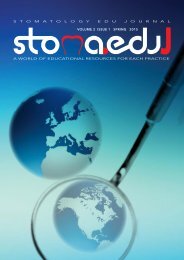Stomatology Edu Journal 1/2014
You also want an ePaper? Increase the reach of your titles
YUMPU automatically turns print PDFs into web optimized ePapers that Google loves.
ETIOLOGICAL CONSIDERATIONS IN BRUXISM<br />
Data Selection: The primary outcome<br />
was bruxism etiology.<br />
Data Extraction: Screening of eligible studies and<br />
data extraction were conducted independently and<br />
in duplicate. The references were analyzed by two<br />
reviewers using the same search strategy and the<br />
same inclusion criteria were applied to the selected<br />
studies. Query terms used were „bruxism”, „etiology”,<br />
and „mechanism”. Among the 95 related articles<br />
that were critically assessed, 31 were included in the<br />
critical appraisal.<br />
3. DATA SYNTHESIS<br />
Internationally, the recent data published in the<br />
literature, shows that there is a consensus regarding<br />
a various etiologic involvement (5) in the pathogenic<br />
mechanisms of bruxism.<br />
The first opinions on the etiology of bruxism were<br />
considered to be the dental bite and the pathology<br />
of muscle contractions. Behavioural factors and<br />
in particular, aspects related to sleep, were also<br />
included as etiological factors (6).<br />
Attanasio R. (7), Lobbezoo et al (8), and Nascimento<br />
et al. (9) showed that the etiology of sleep bruxism<br />
involved local factors, systemic factors, psychological<br />
factors and hereditary factors.<br />
3.1. THE HYPOTHESIS OF OCCLUSAL ETIOLOGY<br />
Regarding local occlusal etiology of bruxism there<br />
were different opinions over time. If in 1966 Ramfjord<br />
et al. (10) believed that occlusal factors, particularly<br />
occlusal interference, would have an important role<br />
in the determination of bruxism, in 1984 Rugh et<br />
al. (11) proved, by creating experimental occlusal<br />
interference, that the role of occlusal disharmony<br />
is secondary to bruxism, since correcting occlusal<br />
interference did not lead to the disappearance of<br />
bruxism. The same situation occurred in patients with<br />
complete edentulism, which in the dentate period<br />
had bruxism. After wearing dentures, the bruxism<br />
reappeared.<br />
However, the first affirmation on the role of occlusal<br />
interference in bruxism was based on the fact that<br />
occlusal interference suppression in patients with<br />
bruxism produced an improvement in symptoms.<br />
This is evident in current dental practice. Ramfjord<br />
(10) called centric bruxism the frequent jaw clenching.<br />
The author argued that when clenching teeth were<br />
accompanied by grinding, this occurred in the central<br />
occlusal area, in the absence of occlusal interference<br />
even in the presence of a stable occlusion, with slight<br />
slip of the teeth, of the mandible from centric relation<br />
to maximum intercuspidation.<br />
Occlusal contacts during sleep, specific to<br />
bruxism, could be interrupted by swallowing, and<br />
muscle forces that appear during bruxism might<br />
exceed those of mastication. During sleep grinding,<br />
electromyographic bursts of the masseter muscle<br />
were observed mainly with mediotrusive mandibular<br />
movement from the canine edge-to-edge position.<br />
According to Minagi et al (12) muscular dynamics<br />
during sleep are unique compared to that during<br />
voluntary clenching, and exert a greater mechanical<br />
load to the balancing side temporomandibular joint.<br />
In 2001, Rosales et al. (13) showed that the<br />
relationship between occlusal disorders and bruxism<br />
was not very consistent. Also, in a review in 2012,<br />
Lobezzo et al (14) concluded that to date, there is<br />
no evidence whatsoever for a causal relationship<br />
between bruxism and the bite.<br />
3.2. MUSCLE ETIOLOGY HYPOTHESIS<br />
There are authors who associated muscle<br />
pathology and bruxism. Hellmann et al (15) argued<br />
that anterior and posterior neck muscles co-contract<br />
during jaw clenching, their findings supporting the<br />
assumption of a relationship between jaw clenching<br />
and the activity of the neck muscles investigated.<br />
3.3. THE HYPOTHESIS OF PSYCHO-BEHAVIORAL<br />
ETIOLOGY<br />
The psycho-behavioural factors whose influence<br />
on bruxism etiopathology is accepted by the majority<br />
of the specialists are: stress, anger, fear, repressed<br />
aggressiveness etc. During the evolution of research,<br />
which had the goal of establishing the etiopathology<br />
of bruxism, an important moment was considered to<br />
be the one when stress was regarded as a decisive<br />
factor.<br />
Rugh and Solberg (16,17) demonstrated the<br />
increase in intensity of bruxism episodes together<br />
with the increase of stress level. Kato (18) took into<br />
consideration the cognitive - behavioural factors<br />
such as stress, personality and anxiety in the etiology<br />
of bruxism and considered that patients with bruxism<br />
presented an anxious personality and that the<br />
dominant of their personality represents the reaching<br />
/ fulfillment of personal goals.<br />
Okeson (19) showed that patients with bruxism<br />
had a greater emotional stability, were more<br />
meticulous and got better learning results. Lavigne<br />
(20) showed that bruxism was connected to anxiety<br />
and was secondary to micro excitations during sleep<br />
(the increase of the cortical activity and cardiac<br />
frequency) followed by the grinding of teeth. Lavigne<br />
(21) pointed out that nocturnal bruxism must be<br />
differentiated from diurnal bruxism, the latter being<br />
linked to the organism’s reaction to stress or anxiety<br />
and being manifested like a contraction tic of the<br />
mobilizing muscles of the mandible.<br />
3.3.1. BRUXISM AS A SLEEP DISORDER<br />
Sleep is an active state which takes 30% of our<br />
time, and is part of our vital behavior being essential<br />
to the survival and life quality of any individual. Sleep<br />
is made up of a succession of repeated stages which<br />
can be pointed out through EEG, EKG, EMG and eye<br />
movements. Specialists described two types of sleep<br />
REM (Rapid Eye Movement) and NREM (Non Rapid<br />
Eye Movement). There are several stages described:<br />
in NREM there are stages 1 and 2 corresponding to<br />
light sleep as well as stages 3 and 4 corresponding<br />
29




